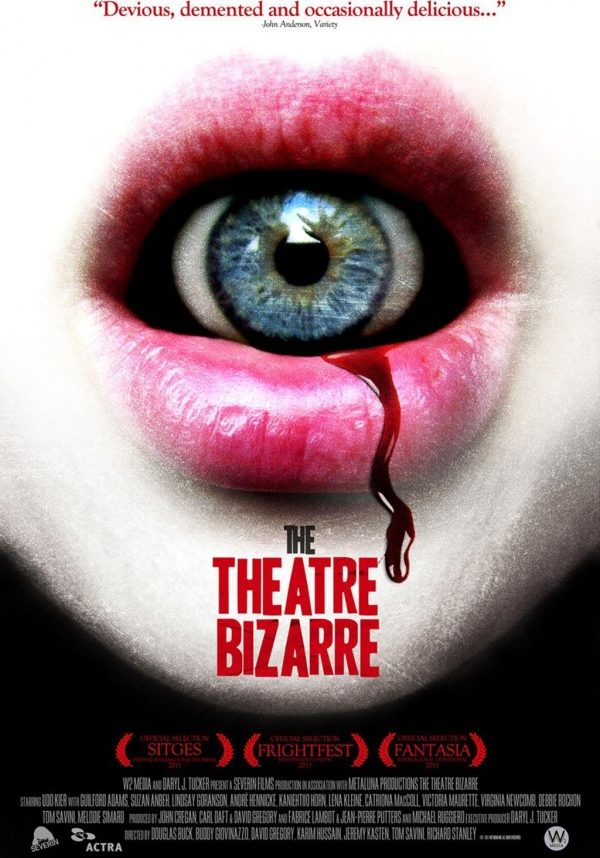A Tapestry of Terror: Unraveling “The Theatre Bizarre”
“Life itself is but a theatre, and we are all actors.” This eerie echo from “The Theatre Bizarre,” a horror anthology unleashed upon the world in 2012, sets the stage for a macabre spectacle. Under the direction of seven distinct filmmakers, including the likes of Tom Savini and Douglas Buck, this collection of terror tales artfully stitches together an omnibus of the obscene. Each segment aims to chill, thrill, and fill the screen with top-tier terror, all framed by the overarching narrative of a woman entranced by a creepy puppet show in an abandoned theater.
Molding the Macabre: Atmosphere, Tone, and Tension
The atmosphere in “The Theatre Bizarre” is a smorgasbord of the sinister. From dimly lit corridors to the otherworldly stillness that precedes chaos, the film employs a diverse range of environments to set its chilling tone. Each director infuses their segment with a unique flavor of fear, whether through the creeping dread of silent anticipation or the visceral immediacy of graphic horror. Pacing plays a key role in constructing this cohesive nightmare, with tension winding and unwinding in a carefully crafted dance that leaves the viewer teetering on the edge of their seat.
Shadows and Screams: Cinematography and Visuals
The cinematography of “The Theatre Bizarre” is a character in its own right. Directors harness shadows and a focused color palette to punctuate the horrors unfolding on screen. The use of close-ups and dutch angles disorient the viewer, plunging them into the chaotic minds of on-screen victims. Special effects range from jaw-dropping practical makeup to discomforting CGI, creating a visual feast that both repulses and fascinates. Furthermore, the integration of avant-garde visuals in segments like “The Accident” underlines the film’s willingness to blur the lines between the grotesque and the beautiful.
Echoes in the Darkness: Soundtrack and Sound Effects
The aural landscape of “The Theatre Bizarre” is laced with discordant melodies and jarring sound effects that underpin the horror. The strategic use of silence amplifies the tension, with the sudden crescendo of strings or the guttural growl of an unseen entity breaking the quiet to devastating effect. The soundtrack is a meticulously chosen array of chilling tunes that complement the on-screen action, enhancing the sense of unease that pervades each vignette.
Legions of the Frightened: Characters and Performances
Horror is nothing without its victims and villains, and “The Theatre Bizarre” parades a veritable gallery of both. The characters are a mixed bag, with some segments offering more nuanced performances and better-developed personas than others. The actors dive headlong into the madness, delivering performances that range from deeply unsettling to over-the-top mayhem. Standouts in the ensemble cast, like Udo Kier’s haunting turn as the puppet show’s master of ceremonies, cement the film’s deeply disturbing ambiance.
The Many Faces of Fear: Elements, Themes, and Mechanics
As an anthology, “The Theatre Bizarre” explores various pockets of the horror genre. With tales that tread through psychological, supernatural, and visceral body horror landscapes, the film is an eclectic mix that defies easy categorization. Its segments confront the audience with an array of fright techniques—from gory spectacles to mind-bending psychological warfare. Some stories leave scars with their biting social commentary, weaving tales of consumerism, vanity, and the human condition, all under the omnipresent shadow of mortality and the grotesque.
A Reflection of Reality: Impact and Underlying Messages
Under the veil of its monstrosities and supernatural overtones, “The Theatre Bizarre” echoes with resonant themes. It provokes thought on issues such as obsession, love’s dark side, and existential angst. By embedding these themes within its horrors, the film lingers in the mind long after the credits roll, raising questions about our place in a world that can be as bizarre and unfathomable as the stories depicted.
The Final Curtain: Who Will Dare to Watch?
The effectiveness of “The Theatre Bizarre” as a horror film is as varied as its segments. Some tales will haunt long after viewing, while others may lean too heavily on shock value. Hardcore horror aficionados will likely revel in its boldness and diversity, but casual viewers or those with a faint of heart might find the jumps between the gory, the absurd, and the profound a bit disjointed. As a contemporary piece, it stands as a grotesque mosaic next to the monolithic tales by masters like Romero and Argento. However, its variety also serves to cast a wider net to attract an audience with different tastes in terror.
Conclusion: An Encore for “The Theatre Bizarre”?
In summation, “The Theatre Bizarre” is a patchwork of horror vignettes that captures a spectrum of what the genre has to offer. Its strengths lie in its variety and commitment to the horrific, although the anthology format inevitably leads to inconsistencies in quality and impact. Potential viewers should be warned of graphic content, which can be quite intense and may trigger discomfort for some. For those who find delight in the darkest corridors of cinema, this collection offers a twisted exploration of the human psyche—that is, if you dare to step into the theatre.




